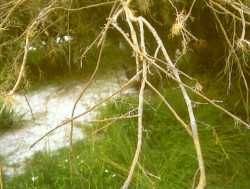Be Alert To Flood Damage Potential In Peach Crops

It doesn’t take a tropical storm or hurricane to create root system damage to peach plantings. Frequent heavy rainfall, like we’ve experienced this past summer, keeps the water table elevated for several weeks. Once the soil is near saturation, it takes only a little rainfall to fill the available pore spaces in the soil and the rootzone becomes saturated. Root injury can occur when the water table remains a few inches below the soil surface, even though roots are not visibly flooded.
Water displaces oxygen and allows anaerobic bacteria (which grow only in the absence of oxygen) to develop rapidly in flooded soils. Toxic sulfides produced by anaerobic sulfur-reducing bacteria can build up and kill roots. Only a small amount of sulfur (3 parts per million) is needed for these bacteria to function. Good drainage allows air to move into the soil and prevents oxygen-deprived conditions. Even under flooding conditions, if the drainage system allows continual water movement in the soil profile, root damage can be minimized. It is when water flow in the soil is slowed or stopped and soil water becomes stagnant that anaerobic bacteria multiply and severe root damage occurs. Peach trees cannot tolerate anoxic (no oxygen due to flooding) conditions for longer than 24 hours.
What To Look For
Even before there are visible tree symptoms, damage can be determined by digging into the soil and smelling root and soil samples. Sour odors or a rotten-egg smell (indicating hydrogen sulfide) is a sign that feeder roots are damaged. A visible symptom of root damage is leaf wilting, which occurs because flooding and the lack of oxygen increase root resistance to water uptake, resulting in transpiration removing more water from the tree than can be replaced by the damaged root system. In peach trees, wilting occurs very quickly and is a good sign that there is significant root system stress due to flooding. Note that flooding injury occurs sooner in hot weather than in cool weather when tree water use is less.
The symptoms of root damage may occur several weeks or months after the actual flooding when drought conditions occur. They usually start to show up after the water table drops and the soil dries out. Symptoms of root damage include leaf yellowing, chlorosis, wilting, fruit drop, leaf drop, and twig dieback. More subtle symptoms include reduced growth and thinner foliage. This can occur at field locations only a few inches lower in elevation than the surrounding area. Harvesting operations or other traffic in and around the trees after flooding may further damage surface roots that have been injured by the flooding.
Managing Root Recovery
Hot, dry conditions following flooding will hasten the onset of stress and symptom expression. The reduced root system resulting from summer flooding is incapable of supporting the existing tree canopy. When this occurs, irrigation management becomes critical. Irrigation must provide moisture to a depleted (shallow) root system but excessive water could compound existing problems. Light frequent irrigations will be required until new roots become re-established. Subsurface moisture should be maintained to promote root growth into the lower rootzone. If root damage is severe, frequent irrigation may even be required throughout the winter months, especially if there are dry winds.
Observation wells are good tools for observing soil-water dynamics. They are the best reliable method for evaluating water-saturated zones in sites subject to chronic flooding injury. Growers can use these wells to measure the rate of water table drawdown. Observation wells constructed with float indicators allow the grower to estimate water table height while driving by the well site. Local offices of the National Resource Conservation Service can assist with water table observation well construction and monitoring. Orchard sites on the sandy soils of the ridge in Central and West Central Florida will not often have areas of chronic flooding and thus water table monitoring is helpful during rainy events, but not critical.
Using topography alone as a diagnostic factor to assess potential for flood damage may be misleading. Flooding damage can occur in obvious spots such as poorly drained depressions, but also it may be present where least expected. Flooding injury has been observed on hillsides, on relatively high ground, on isolated areas of flat land, and even on raised beds. Hillsides may have pockets of clay. In flat areas, the problem may be impervious clay, marl, or organic layered pockets that hold the water and prevent movement. Even beds in apparently uniform sandy areas can have buried palmetto roots and organic materials. These areas are subject to root damage since the soils are able to support anaerobic bacteria if flooded.
Flooding requires that tree management be intensified to minimize the effects of stress on water-damaged trees. Flooding will not always damage tree root systems unless the soil is saturated longer than 24 hours, but trees should be closely monitored for symptoms. Duration of flooding conditions, rate of water table draw-down, presence of sulfur or organic matter in the soil, nature of the soil, tree age, rootstock, and root condition are all factors to be considered when trying to evaluate flooding injury and manage tree recovery. Other cultural practices should be adjusted to minimize stress on water-damaged trees. Fertilization rates and schedules may need to be adjusted for flood-damaged trees. Light fertilizer applications are preferred until the root system becomes reestablished. Once the immediate drainage problem has been alleviated, the appropriate course of action is to wait, observe, and let tree response guide the course of action.









